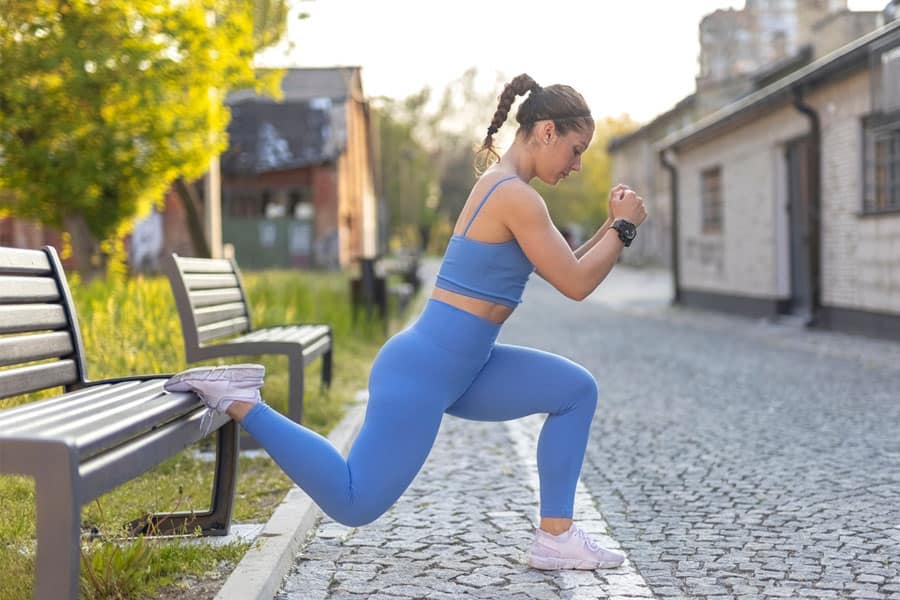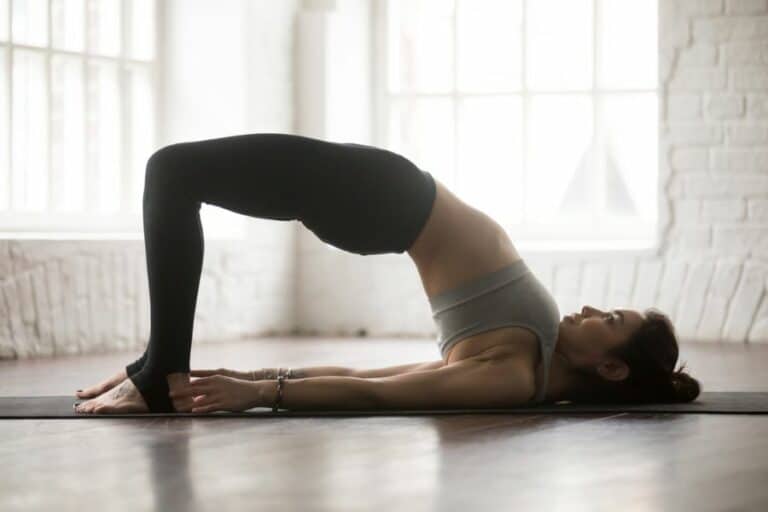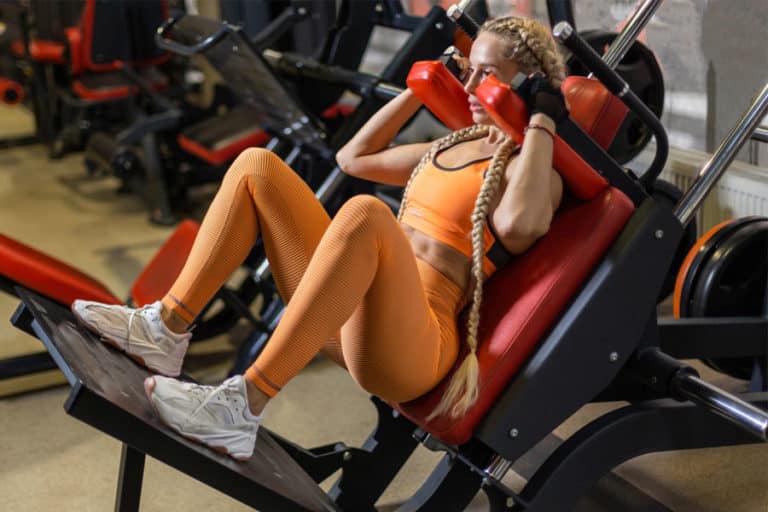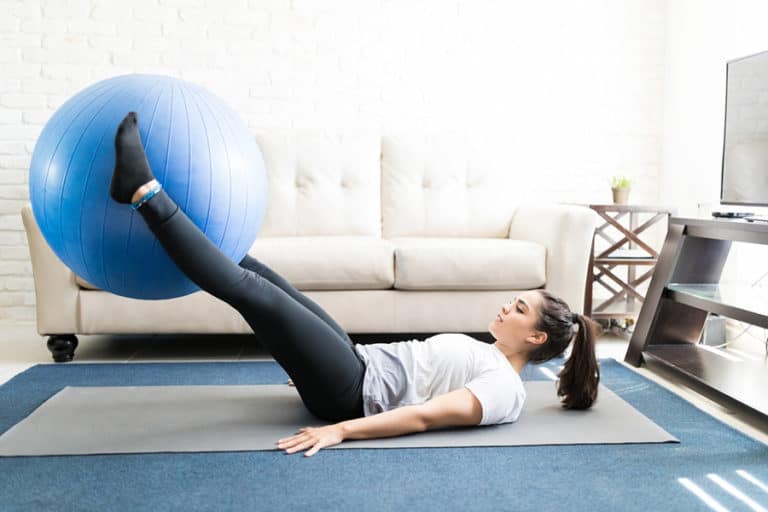Bulgarian Split Squat-Overview, Variations, and Benefits

How to do | Muscles Worked | Who should/should not | Add to routine | Safety Tips | Benefits | Variations
The Bulgarian split squat is one of the most dynamic variations of squats. Olympic weightlifting coach Angel Spassov was the one to make this single-leg squat exercise famous in the USA in the 80s.
It is also known as RFESS (rear foot elevated split squat). It is a great exercise for developing lower body strength and can be performed with or without weights. It works wonders for beginners or those looking to add variety to their workout routine.
How to do a bulgarian split squat?
Equipment required: A bench or box or any other raised surface.
- Start by standing with your feet hip-width apart.
- Place your left foot flat behind you on a raised surface.
- Keep your right foot planted firmly on the floor.
- Place your hands on the side of your hips or extend them in front for balance and brace your core.
- Slowly lower your body down into a deep lunge position, keeping your chest up and shoulders back.
- Do not allow your right knee to go over the toes.
- Lower your body until your right thigh is parallel to the ground and hold the stance for a moment.
- Push through the heel of your front foot to return to the starting position.
Note: Beginners may place their rear leg on the floor instead of an elevated surface as they start with the Bulgarian split squat. As they gain confidence, they may later place their back leg on a chair/box
Muscles worked
Bulgarian split squats are a compound exercise [1]The American Council on Exercise: 5 Benefits of Compound Exercises. This exercise targets all the major muscle groups in the lower body. Given below is a thorough explanation of the muscles that are activated at different stages of the exercise:
Primary muscles worked:
| Glutes | gluteus maximus, gluteus medius |
| Quads | vastus medialis, vastus lateralis, rectus femoris, vastus intermedius |
| Hamstrings | semitendinosus, biceps femoris, semimembranosus |
| Calves | gastrocnemius, plantaris, and soleus |
Secondary muscles activated:
| Inner and outer thigh muscles | adductors and abductors |
| Muscles in the pelvic floor | transversus abdominis |
| Abdominal muscles | obliques |
| Spinal muscles | spinal erectors |
Who should and should not do bulgarian split squats?
People of all fitness levels can perform the Bulgarian split squat. However, here are specific categories of people that should definitely include or refrain from this exercise:
Who should do:
- Bodybuilders and powerlifters who wish to strengthen and bulk up their quads and glutes may include the Bulgarian split squat with weights into their regime to get the optimal result.
- For any kind of sports athlete [2]Research Gate: The integration of unilateral strength training for the lower extremity within an athletic performance programme pdf looking to increase their athletic power, endurance, or an additional challenge of a unilateral exercise [3]Colorado State University: Should you be doing more unilateral training? that does not cause joint strain. They can do it with or without weights as per their requirements.
- Anyone interested in having toned or bulked-up legs must include the Bulgarian split squat in their routine.
Who should not:
- Anyone with weak knees or ankle joints may face difficulties performing this exercise. The range of motion of the Bulgarian split squat loads all the weight only on one leg. This may cause injury in the front leg to those with pre-existing pain.
- Beginners are advised to add this exercise to their routine only if they are confident with their balancing skills and flexibility.
Adding it to your routine
The Bulgarian squat is an exercise that people of all fitness levels can perform. That makes it easy to incorporate into anyone’s routine. Here’s how:
As a stand-alone exercise
- Beginner level: 1-2 sets of 8-15 reps.
- Intermediate/advanced level: 2-5 sets of 8-16 reps (ideally with weights).
Incorporating into a circuit
Here is a sample workout routine for beginners to incorporate bulgarian splits into their fitness regime.
| Beginner Level Exercises | Reps |
| Warm-up: Cardio (Jumping Jacks/Running) | 3-5 Minutes |
| Leg lifts | 10-12 reps |
| Bulgarian split squats | 15 reps |
| Kettlebell swings | 12 reps |
| Cat-cow pose (Cooldown) | 1-2 minutes |
If you are an intermediate or advanced-level fitness enthusiast, here is a sample workout routine to incorporate your bulgarian splits into your fitness regime.
| Intermediate/Advanced Level Exercises | Reps |
| Warm-up: Cardio (Jumping Jacks/Running) | 3-5 Minutes |
| Bulgarian split squats | 15 reps |
| Leg Extensions | 12 reps |
| Hamstring curls | 10 reps |
| Seated single-leg hamstring stretch and child pose (cooldown) | 1-2 minutes |
Note: You may add or reduce weights and reps as per your fitness goals and physical capacity.
Safety tips
It is best to be cautious when doing Bulgarian split squats to avoid any injuries. Here are some safety tips to keep in mind while performing the exercise:
- Warm up before you begin.
- The placement of your back leg should be such that there is enough gap between both your thighs to establish balance.
- To gain the full benefit of the exercise, complete the entire range of motion.
- Moreover, the distance between the bench and yourself should not be too far or not too close. Ideally, you should be standing 2-3 steps in from the bench.
- Keep your torso upright, and your core engaged throughout the exercise. If you lean forward excessively, it may also cause you to lose your balance and strain your lower back.
- Keep all the weight on the front foot and focus on using your glutes and quads to move up and down. If your back leg is doing most of the work, you’re not effectively targeting your muscles.
- If you feel any pain or discomfort, immediately discontinue the exercise and check with your health care provider.
- Do not push yourself to add weights or reps if you are physically unable to do it.
- Rest for 24 to 48 hours to recover thoroughly before training the same muscle groups.
Benefits of the bulgarian split squat
Many benefits come with doing the Bulgarian split squat regularly. Here are some of the most noteworthy ones:
- This compound exercise works and strengthens multiple muscle groups simultaneously.
- The strengthening of the quad muscles may cause the legs to bulk up, and thus they may appear larger in size.
- The range of motion of the exercise challenges your core muscles. This, in turn, stabilizes your body throughout the move. This makes them stronger over time.
- As this move requires you to place one foot in the front and the other behind, it helps to improve your balance and coordination.
- Additionally, the range of motion involved in the move helps improve your hip and ankle mobility.
- Resistance exercises like the Bulgarian split squat have been shown to increase the body’s growth hormone and testosterone levels [4]American Physiological Society: Effects of heavy-resistance training on hormonal response patterns in younger vs. older men. This, in turn, can help build muscle mass, improve strength, and speed up recovery.
- Unlike many other squat exercises, the Bulgarian split squat is a single-leg exercise. It needs you to push through using one leg alone. Thus alleviating the pressure off your lower back.
- As it is a unilateral exercise, it is easier to identify differences in strength in each leg. This makes it easier to identify muscle imbalances [5]The American Council on Exercise: The Benefits of Unilateral Training and work on them efficiently.
Bulgarian split squat vs. lunges vs. single-leg squat
These three may appear to be similar. However, they each target different muscle groups and offer different benefits.
Bulgarian split squat
The Bulgarian split squat requires you to squat with one foot in the front planted on the floor and the other foot elevated on a bench/box behind.
It is a unilateral exercise that primarily works the quads, glutes, and hamstrings. Additionally, it also challenges the core and the rare leg. It stabilizes the body and improves your balance. This move is a great way to boost lower body strength and build muscle mass.
Single-leg squat
Unlike the Bulgarian split squat, the single-leg squat is performed with one leg extended in the front, parallel to the floor.
This is also a unilateral compound exercise that works the same muscles as the Bulgarian split squat. It improves balance and flexibility as it doesn’t use any other support except the one leg planted on the floor.
This move works well on your legs and builds muscle mass. It is also a good option for those on an intermediate level or for those looking for a bigger challenge.
Lunges
Lastly, lunges are functional exercises that involve taking one step forward and then lowering the body toward the floor. At the top of this movement, the thigh of the front leg and the calf of the rear leg should be parallel to the floor.
This compound exercise works the quads, glutes, and hamstrings. However, they are a little less challenging than the Bulgarian split squat and single-leg squat, as both feet are planted on the floor.
Lunges tone the legs and improve their strength. They make a great beginner-friendly exercise.
Variations to try
To add some variety to your workout routine, here are 5 Bulgarian split squat variations:
Resistance band Bulgarian split squat
In this variation of the Bulgarian split squat, you place a resistance band under the foot placed on the ground. Wrap the other end around your shoulders. Now perform the squat movement.
The band will provide a little more resistance, making your normal Bulgarian split squat more challenging.
Bulgarian Split Squat with a barbell
If you want to make a move more challenging, try holding a barbell across your back while performing the Bulgarian split squat.
This will place additional resistance on your muscles and help to increase strength further.
Dumbbell Bulgarian split squat
Another way to make the Bulgarian split squat more challenging is to hold dumbbells in each hand while performing the move.
This will help to increase the intensity of the workout and work your muscles even harder.
Bulgarian split squat with exercise ball
If you want to work your core muscles, even more, try placing an exercise ball instead of the bench/box while performing the Bulgarian split squat.
This will force your core to work overtime in order to stabilize your body.
Walking lunges
Walking lunges are a great way to add some cardio to your Bulgarian split squat routine. To do this variation, simply perform a lunge forward with your right leg and then follow it up with a lunge forward with your left leg.
Repeat this movement until you have completed the desired number of repetitions.
Conclusion
To sum up, the Bulgarian split squat is a great single-leg exercise for toning the legs and building muscle mass. It is also a good option for those on any level. Remember to keep the safety tips in mind and maintain the proper Bulgarian split squat form to get the most out of this exercise.
References
| ↑1 | The American Council on Exercise: 5 Benefits of Compound Exercises |
|---|---|
| ↑2 | Research Gate: The integration of unilateral strength training for the lower extremity within an athletic performance programme pdf |
| ↑3 | Colorado State University: Should you be doing more unilateral training? |
| ↑4 | American Physiological Society: Effects of heavy-resistance training on hormonal response patterns in younger vs. older men |
| ↑5 | The American Council on Exercise: The Benefits of Unilateral Training |








